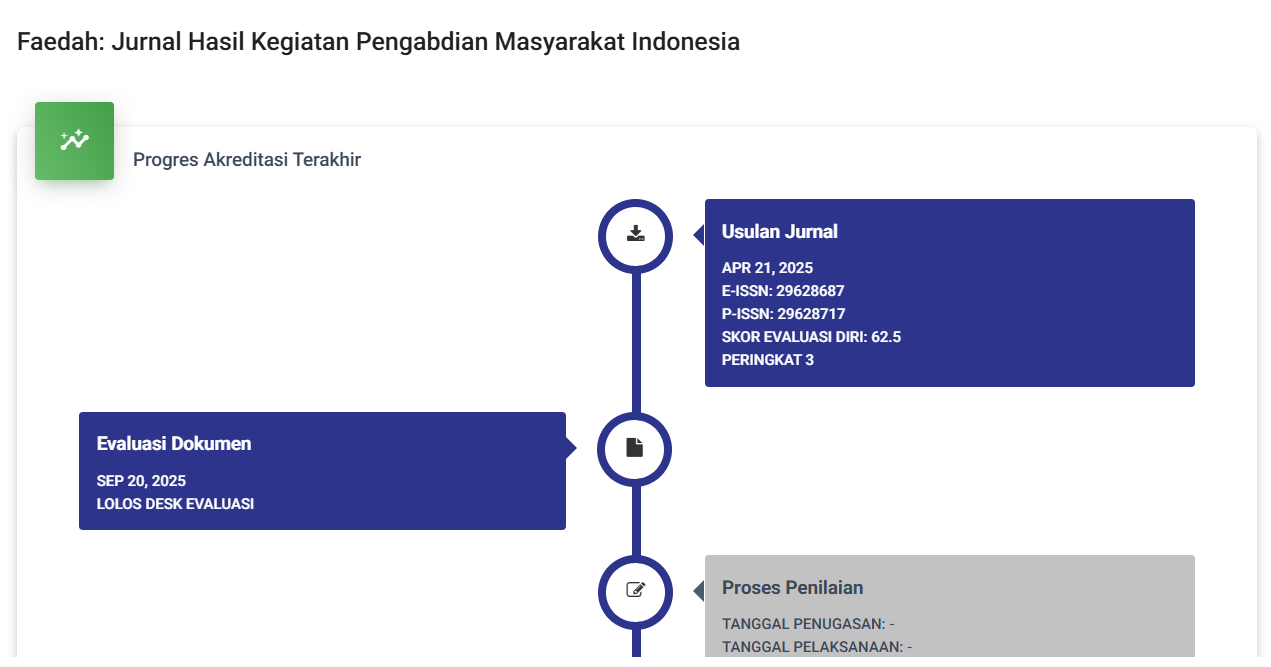Pemberdayaan Masyrakat dalam Pengembangan Desa Wisata Berbasis Digital di Desa Gogik Kabupaten Semarang
DOI:
https://doi.org/10.59024/faedah.v2i3.1008Keywords:
Community Empowerment, Digital-Based Tourism Village Development, PokdarwisAbstract
Gogik is a village that has two hamlets, Gogik and Gintungan hamlets. Gogik Village is located in West Ungaran District, Semarang Regency, Central Java. The area of Gogik village is around 18,000 m2, with the border of the village area from the north namely Candirejo Village, east of PTPN IX, south of Gebugan Village, and west by Langensari Village. The climate of Gogik village is at an altitude of 600 meters above sea level with an average daily temperature of 27, so the atmosphere is very cool. Gogik Village is a village with a lot of potential in nature, culture and traditions that are still maintained today. As for one of the natural potentials that exist in the village such as: Semirang waterfall, Embung Sukoponco, Kebon Nutmeg PTP Ngobo, local food from Gogik Village, and of course the panoramic view of the foot of Mount Ungaran, as well as several other potentials. The potential is very much, of course, efforts are needed to optimize it to support Gogik Village as a digital-based Tourism Village. POKDARWIS is one of the tourism-aware organizations in Gogik village, with quite good community participation, but still not supported by qualified skills in using IT to promote the village's potential. This is certainly an obstacle in the development of digital-based tourism villages. Therefore, the UNNES service team will collaborate with the POKDARWIS institution (Tourism Awareness Group) Gogik Village, West Ungaran District, Semarang Regency to optimize regional potential through various kinds of digital-based tourism promotion training, production and packaging of regional specialties so that they can be used as souvenirs, utilization of drone media and video editing for promotion of Gogik village tourism. With innovation and creativity in promoting the natural potential that exists in Digital-based Gogik Village, it can have a big impact on improving the welfare of the village community. The output targets of this service are articles published in journals, articles published in mass media and activity videos.
References
[UU] Undang-undang Republik Indonesia Nomor 6 Tahun 1990 Tentang Kepariwisataan.
Brida, J. G., & Zapata, S., (2010) "Cruise Tourism: Economic, Sosio-Cultural and Enviromental Impacts",Int. J. Leisure and Tourism Marketing1(3), 205- 226.
Dewi, Made Heny Urmila. Chafid Fandeli dan M. Baiquni. 2013. Pengembangan Kelurahan Wisata Berbasis Partisipasi Masyarakat Lokal Di Kelurahan Wisata Jatiluwih Tabanan, Bali. Kawistara. Vol 3 No 2 Hal 129- 139.
Kemenkraf/Baparekraf. (2022). Perekonomian tumbuh da sektor pariwisata akan memacu pemulihan ekonomi. https://pedulicovid19.kemenparekraf.go.id/perekonomian-tumbuh-dan-sektor-pariwisata-akan-memacu-pemulihan-ekonomi/
Mackinnon, K, G. Hatta, H. Halim dan A. Mangalik. (2000). Ekologi Kalimantan. Alih Bahasa Gembong Tjitrosoepomo. Jakarta : Pernerbit Prenhallindo.
Mubyarto. 1997. Ekonomi Rakyat, Program IDT dan Demokrasi Ekonomi Indonesia. Yogyakarta: Aditya Media
Mustofa,Mohammad Solehatul. 2016. Pengembangan Pariwisata PeKelurahanan Berbasis pemberdayaan Masyarakat Di Kelurahan Pakintelan Kecamatan Gunungpati Kota Semarang. Semarang: Penelitian Unggulan Unnes.
Nababan, D, Safalia, I. 2012. “Analisis Personal Financial Literacy dan Financial Behavior Mahasiswa Strata I Fakultas Ekonomi Universitas Sumatera Utara”, diperoleh dari http://jurnal.usu. ac.id/index.php/jmim/article/view/651/pdf
Oseifuah, Emmanuel Kojo. 2010. Financial Literacy and Youth Entrepreneurshipin South Africa.Thohoyandou: Department of Accounting and Auditing University of Venda.
PIR – Pariwisata Inti Rakyat (Undang-Undang Otonomi Daerah (UU. No. 22/99)
PP Peraturan Pemerintah Republik Indonesia Nomor 73 Tahun 2005 Tentang Kelurahan
Pranoto, H., & Wibowo, A. (2018). Identifikasi Nilai Kearifan Lokal (Local Wisdom) Piil Pesenggiri Dan Perannya Dalam Dalam Pelayanan Konseling Lintas Budaya. JBKI (Jurnal Bimbingan Konseling Indonesia). https://doi.org/10.26737/jbki.v3i2.714
Sagala, Syaiful. 2008. Konsep dan makna pembelajaran. Bandung : Alfabeta.
Sugiman, S. (2018). Pemerintahan Desa. Binamulia Hukum, 7(1), 82–95. https://doi.org/10.37893/jbh.v7i1.16
UU Nomor 10 tahun 2009 tentang Kepariwisataan
UU Nomor. 6 tahun 2014 tentang Desa.
UU Nomor9 Tahun 1990 tentang kepariwisataan
Warpani, Suwardjoko P dan Indira P Warpani. 2007. Pariwisata dalam Tata Ruang Wilayah. Bandung: ITB
Yakup Permata A. (2019). Pengaruh Sektor Pariwisata Terhadap Pertumbuhan Ekonomi di Indoensia. Tesis. Universitas Airlangga Surabaya. https://repository.unair.ac.id/86231/1/TE.%2005- 19%20Yak%20p%20ABSTRAK.pdf
Yoeti, Oka A. 1996. Pengentar Ilmu Pariwisata. Bandung: Angkasa.
Downloads
Published
How to Cite
Issue
Section
License
Copyright (c) 2024 Faedah : Jurnal Hasil Kegiatan Pengabdian Masyarakat Indonesia

This work is licensed under a Creative Commons Attribution-ShareAlike 4.0 International License.









